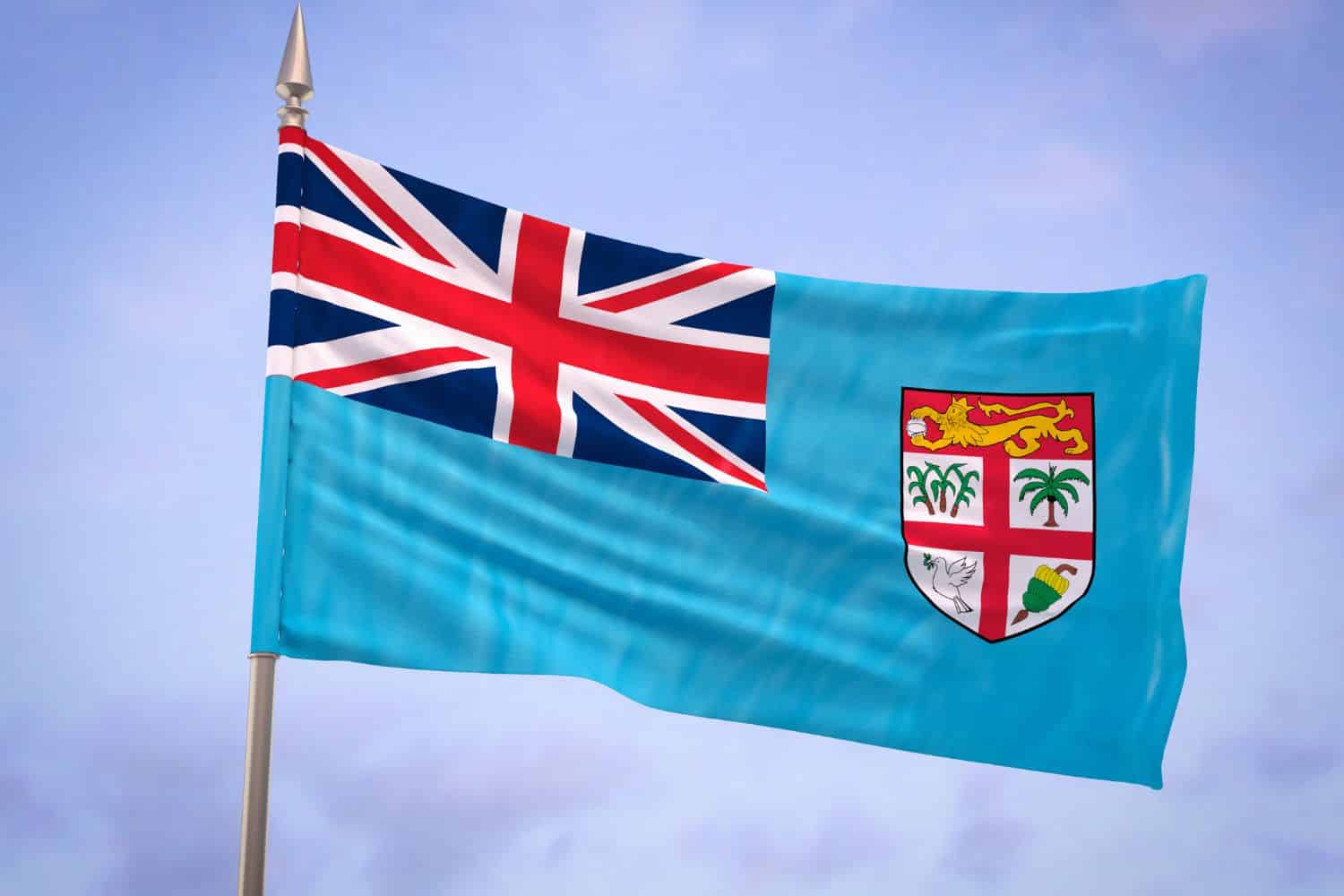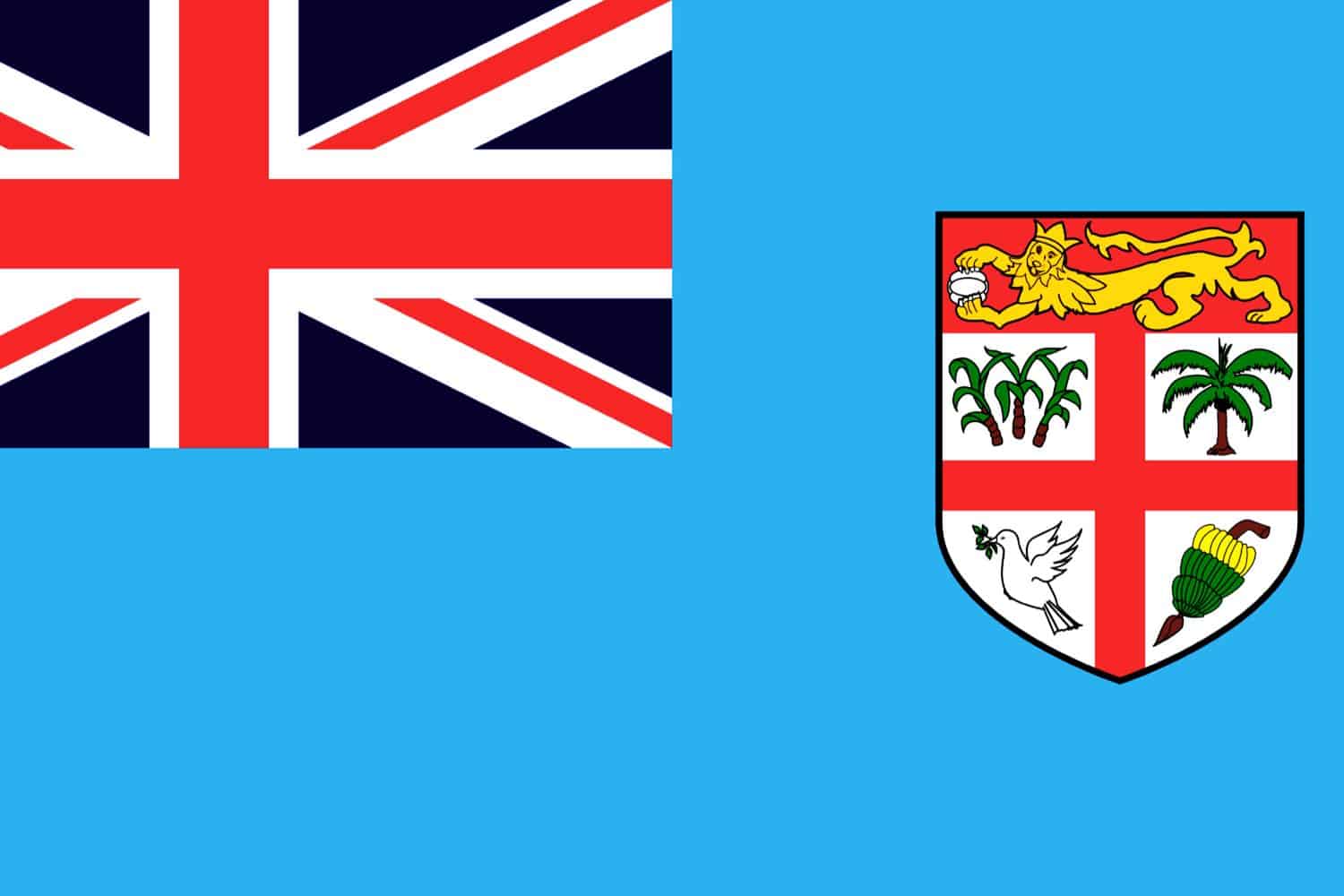Table of Contents
The Fijian flag, also recognized as the flag of Fiji, carries profound cultural and historical significance for the country. It serves as a symbol of identity, resilience, and aspirations of the Fijian people. In this piece, we delve into the captivating elements of the Fijian flag, including its design, symbolism, and historical context.
The Fijian flag showcases a light blue field with the Union Jack in the top left corner and the Fijian coat of arms on the right side. The light blue color represents the surrounding Pacific Ocean, an integral part of Fiji’s geography and identity. The Union Jack symbolizes Fiji’s historical ties with the British Empire, while the coat of arms embodies the nation’s rich heritage and cultural diversity.
Fijian Flag: Union and Heritage
- The design of the Fijian flag features a sky-blue field with the Union Jack in the canton and the Fijian coat of arms on the fly.
- The coat of arms includes images of a shield depicting a heraldic lion holding a cocoa pod, sugarcane, a palm tree, bananas, and a dove with olive branch, all symbolizing various aspects of Fiji’s economy, resources, and aspirations for peace.
- The Union Jack acknowledges Fiji’s historical association with Britain.
- The flag was officially adopted on October 10, 1970, marking Fiji’s independence from British colonial rule.
- The symbolism of the flag embodies Fiji’s commitment to sovereignty, cultural richness, and unity, reflecting the nation’s journey towards independence and its enduring values.
Flag of Fiji

The flag of Fiji also stands as a poignant emblem, encapsulating the essence of the nation’s cultural legacy and ethos. Its design comprises a light blue background with the Union Jack in the upper left corner and a shield featuring a cross and a lion positioned at the center. The light blue color signifies the Pacific Ocean, symbolizing Fiji’s maritime location and connection to the sea. The Union Jack represents Fiji’s historical ties to Great Britain, highlighting a chapter in the nation’s colonial past. The shield embodies Fiji’s cultural diversity and Christian heritage, with the cross symbolizing faith and the lion representing strength and bravery.
The history of the Fijian flag is intricately woven into the fabric of the nation’s heritage and its journey towards independence. Originally adopted on October 10, 1970, the flag serves as a unifying emblem for the Fijian people, embodying their collective identity and aspirations.
Beyond its physical appearance, the Fijian flag carries profound symbolic significance. Its colors and symbols reflect the values and dreams of the Fijian populace, portraying the nation’s connection to the ocean, its diverse cultural heritage, and its Christian faith. The Union Jack serves as a reminder of Fiji’s colonial past, while the shield represents the nation’s resilience and unity amidst its rich cultural tapestry.
National Flag Etiquette and Protocol

Maintaining the appropriate use and display of the Fijian flag is paramount. Understanding the etiquette involved in handling the flag, especially during national ceremonies and events, is essential. It is important to be informed about the rules that dictate the handling, hoisting, and lowering of the flag. Additionally, one must know the correct procedures for retiring or managing damaged flags to ensure they are treated with the respect they deserve.
- Proper Handling: It is essential to handle the Fijian flag with care and reverence, preventing it from touching the ground or the floor. It must always be held upright and never dragged along any surface.
- Hoisting and Lowering: The flag should be hoisted briskly and lowered ceremoniously. The general practice is to hoist the flag at sunrise and lower it at sunset, although adjustments can be made depending on specific guidelines or the occasion at hand.
- Displaying the Flag: When displaying the flag, it should have the blue field at the top with the Union Jack and coat of arms positioned centrally. It is important to allow it to fly freely, without being entangled or obstructed in any way.
- Half-Staff: On certain days of remembrance or during national tragedies or the passing of important figures, the flag should be flown at half-staff as a sign of mourning or respect, following directives from the relevant authorities.
- Flag Retirement: When the Fijian flag becomes damaged or worn out, it should be retired gracefully and respectfully. This may involve burning it in a solemn and respectful ceremony, in line with the proper guidelines and local regulations.
- Flag Size and Placement: The size of the flag that is displayed should be in proportion to the flagpole or the display area. It is recommended to follow the advice of local authorities or guidelines for specific details on flag size and placement.
Respectful Disposal: In instances where burning is not a feasible option for flag retirement, the flag should be disposed of respectfully, either by burying it or giving it to authorized organizations that specialize in flag disposal.
Fascinating Facts and Trivia

Embark on a journey of intriguing facts and lesser-known trivia about the Fijian flag. Uncover unique aspects within the flag’s design that carry hidden symbolism. Explore tales of notable incidents or events involving the flag, which have deeply influenced the nation’s history and sense of identity.
Rich Tapestry of History
- 1970: Fiji adopts its current flag on October 10, encapsulating the unity and aspirations of the Fijian people.
- Colors and Symbolism: The light blue color represents the Pacific Ocean, surrounding the Fijian islands, while the white color in the shield symbolizes purity and unity.
- Shield and Crossed Spears: The shield and crossed spears at the center of the flag represent Fiji’s heritage, strength, and readiness to defend its sovereignty.
- National Identity: The flag embodies Fiji’s diverse cultural heritage, its connection to the ocean, and the nation’s ongoing pursuit of unity, prosperity, and progress.
These historical insights shed light on significant moments in the history of the Fijian flag, underscoring its role in shaping Fiji’s national identity and symbolizing its struggles and aspirations over the years.
Flag-Related Symbols and Emblems
A flag is just one aspect of a nation’s identity. Explore additional national symbols and emblems closely associated with Fiji, understanding their significance and their relationship to the flag. Delve into their historical and cultural significance, further enhancing your appreciation of Fiji’s rich heritage. Embark on a journey to Fiji and explore its top destinations firsthand.
Symbolisms of the Fijian Flag
The flag of Fiji embodies several symbolic representations that encapsulate the nation’s rich history, cultural values, and aspirations. Presented below are the symbolisms of the Fijian flag in an itemized format:
- Blue Color: Represents the vast Pacific Ocean surrounding the islands of Fiji, signifying the nation’s maritime location and connection to the oceanic environment.
- Union Jack: The presence of the Union Jack pays homage to Fiji’s colonial history as a former British colony, reflecting the country’s historical ties with the United Kingdom.
- Coat of Arms: The shield in the center of the flag features symbols representing Fiji’s natural resources, including sugarcane, coconuts, and bananas, which are vital to the nation’s economy and agricultural heritage.
- Dove: Positioned above the shield, the dove symbolizes peace, unity, and national aspirations for harmony among Fiji’s diverse population.
- Crossed Swords: Flanking the shield, the crossed swords signify Fiji’s readiness to defend its sovereignty and uphold its values, as well as the nation’s military tradition and commitment to peacekeeping efforts.
- Flag’s Design: The layout and composition of the flag reflect Fiji’s cultural diversity, history, and aspirations for unity and progress as a sovereign nation.
- National Identity: The flag serves as a potent symbol that unites the people of Fiji, reminding them of their shared heritage, values, and cultural identity.
- National Aspirations: Through its design and elements, the flag embodies the aspirations and values of the Fijian nation, including peace, unity, resilience, and cultural pride.
These symbolisms embedded within the Fijian flag contribute to the country’s collective identity and pride, encapsulating its historical journey and cultural significance.
Flags of Similar Countries or Regions
Embark on a fascinating journey through the flags of nations or regions neighboring Fiji. Delve into a detailed examination of these flags, discerning both their similarities and differences in terms of design, colors, and symbolism. Uncover the historical and cultural affinities shared among these flags, illuminating connections and distinct identities.
Fijian Flag vs Tongan Flag

Similarity: Both flags prominently feature the color red.
Difference: The Tongan flag includes a white rectangle in the upper left corner of the red field.
Fijian Flag vs Samoan Flag

Similarity: Both flags prominently use blue and red.
Difference: The Samoan flag features a blue field with a white rectangle and a red cross in the upper left corner.
Fijian Flag vs Tuvaluan Flag

Similarity: Both flags incorporate the color blue.
Difference: The Tuvaluan flag consists of a light blue field with nine yellow stars arranged in a circle in the center.
Fijian Flag vs Vanuatuan Flag

Similarity: Both flags incorporate the color red.
Difference: The Vanuatuan flag features a green field with a yellow horizontal stripe and a black triangle in the left corner.
Frequently Asked Questions (FAQs)
Explore answers to common questions regarding the Fiji flag picture. From its historical background to the meanings behind its elements, find succinct and enlightening responses to inquiries frequently raised by those interested in Fiji’s flag.
What are the colors of the Fijian flag and what do they represent?
The Fijian flag features the colors light blue, symbolizing the Pacific Ocean; yellow, representing the sun; and red, signifying the blood shed during Fiji’s struggles for independence.
How many stars are on the Fijian flag and what do they represent?
There are five stars on the Fijian flag, which symbolize the constellation of the Southern Cross, a prominent feature of the southern hemisphere sky.
What is the significance of the Union Jack on the Fijian flag?
The Union Jack in the upper left corner of the Fijian flag reflects Fiji’s historical ties to the United Kingdom as a former British colony.
When was the current design of the Fijian flag adopted?
The current design of the Fijian flag was adopted on October 10, 1970, upon Fiji’s independence from British colonial rule.
Are there any restrictions on the use or display of the Fijian flag?
Yes, there are guidelines and protocols for the respectful and appropriate use of the Fijian flag, including rules regarding its display, handling, and treatment during official and ceremonial events.
What is the significance of the shield on the Fijian flag?
The shield on the Fijian flag represents the country’s heraldic history and cultural heritage, embodying strength, unity, and protection.
Has the design of the Fijian flag undergone any changes since its adoption?
No, the design of the Fijian flag has remained unchanged since its adoption in 1970, symbolizing continuity and national identity.
What is the ratio of the Fijian flag’s dimensions?
The Fijian flag has a ratio of 1:2, meaning its width is double its height.
